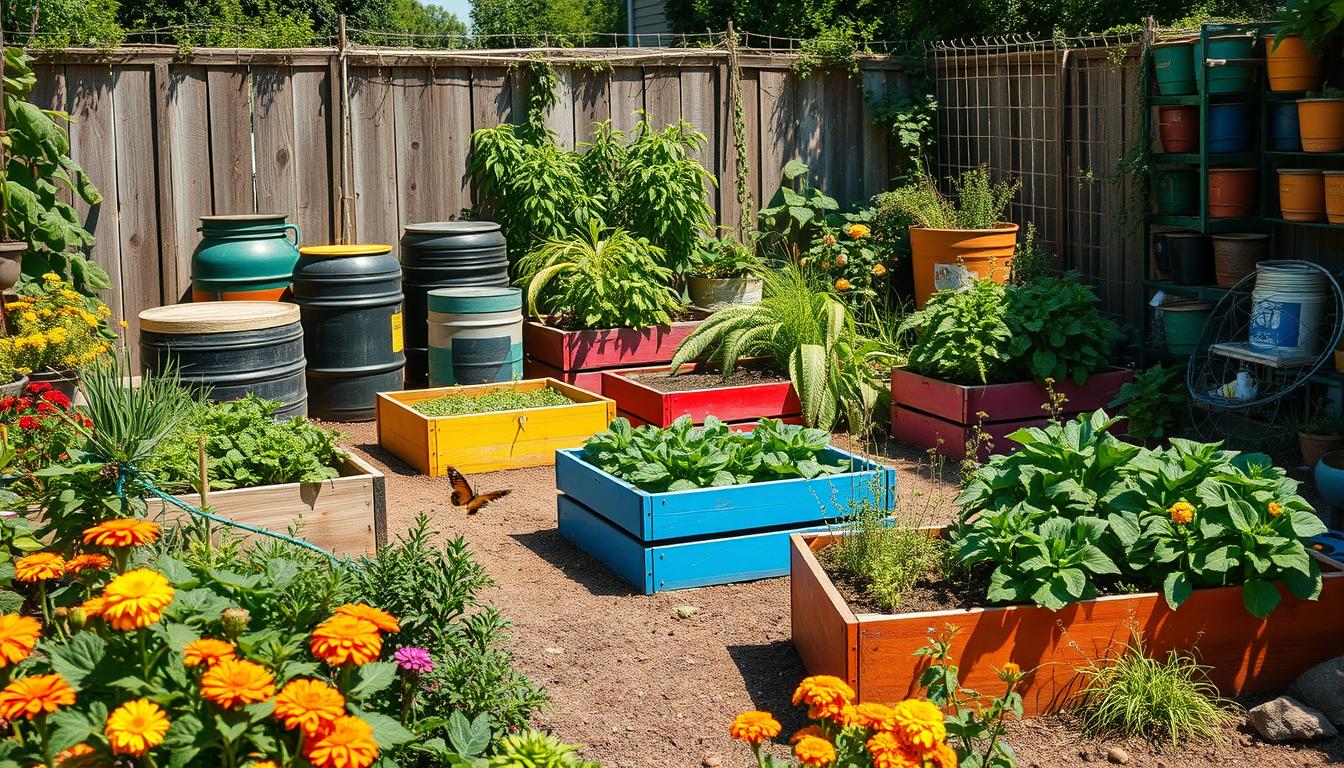I’m excited to share my zero-waste gardening ideas with you. These ideas focus on sustainable gardening tips and eco-friendly practices. As a gardener, I’ve learned that reducing waste is key for a healthier environment for my plants and the planet.
By adopting zero-waste gardening ideas, you can greatly reduce your environmental impact. I’ll share practical advice on sustainable gardening tips and eco-friendly practices that are easy to follow.
In this article, I’ll show you how to create a thriving garden using zero-waste gardening ideas. My goal is to inspire you to make a positive impact on the environment, one garden at a time.
Understanding Zero-Waste Gardening Principles
Exploring zero-waste gardening has shown me how crucial it is to cut down on waste. By using organic and eco-friendly gardening methods, we can greatly reduce our environmental impact. This approach helps our plants thrive in a healthier environment.
Zero-waste gardening is all about reducing, reusing, and recycling. This is key to making our gardens more sustainable.
Starting with zero-waste gardening has many benefits. It helps us save water, cuts down on landfill waste, and supports a greener garden. Here are some ways to reduce waste:
- Composting food scraps and yard waste to create nutrient-rich soil
- Using rainwater harvesting systems to collect and conserve water
- Repurposing materials like old containers and cardboard to create planters and mulch
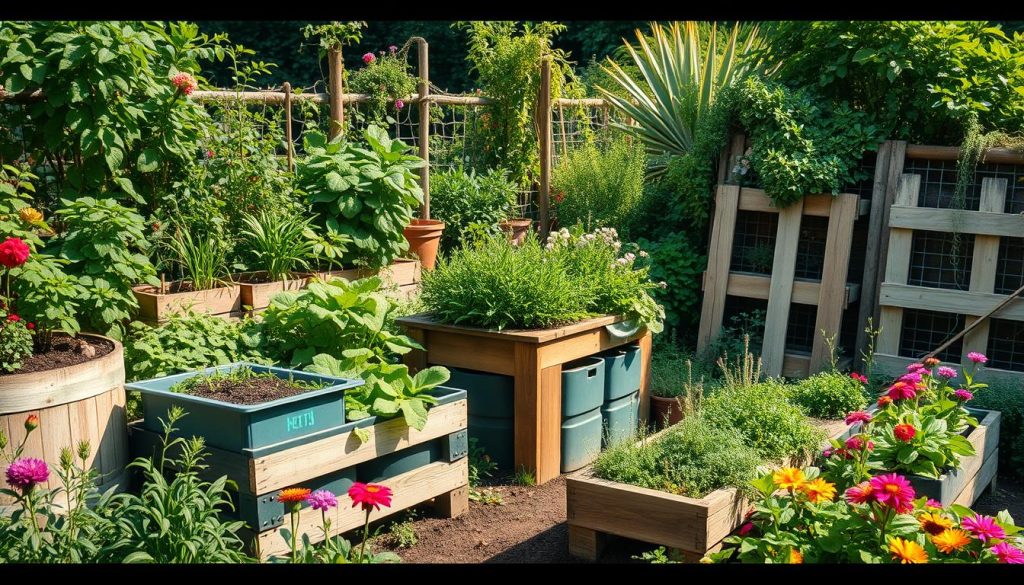
By adopting these eco-friendly gardening habits, we can greatly help our planet. Next, we’ll look into the role of composting in creating a vibrant garden ecosystem.
Composting: The Heart of Zero-Waste Gardening
Exploring zero-waste gardening, I see composting as key. It helps cut down on landfill waste and makes a natural plant food. Composting is a basic yet powerful way to live waste-free.
Composting turns kitchen and yard waste into soil full of nutrients. This is vital for plants to grow well. It’s a green way to garden and cuts down on waste. Some top composting methods are:
- Vermin composting: using red worms to break down food scraps
- Bokashi composting: fermenting food waste to create a nutrient-rich liquid fertilizer
- Hot composting: creating a compost pile that reaches high temperatures to kill weed seeds and pathogens
To compost well, mix “green” and “brown” materials, keep it moist, and turn it often. By doing this, I help my garden grow and lessen my environmental footprint.
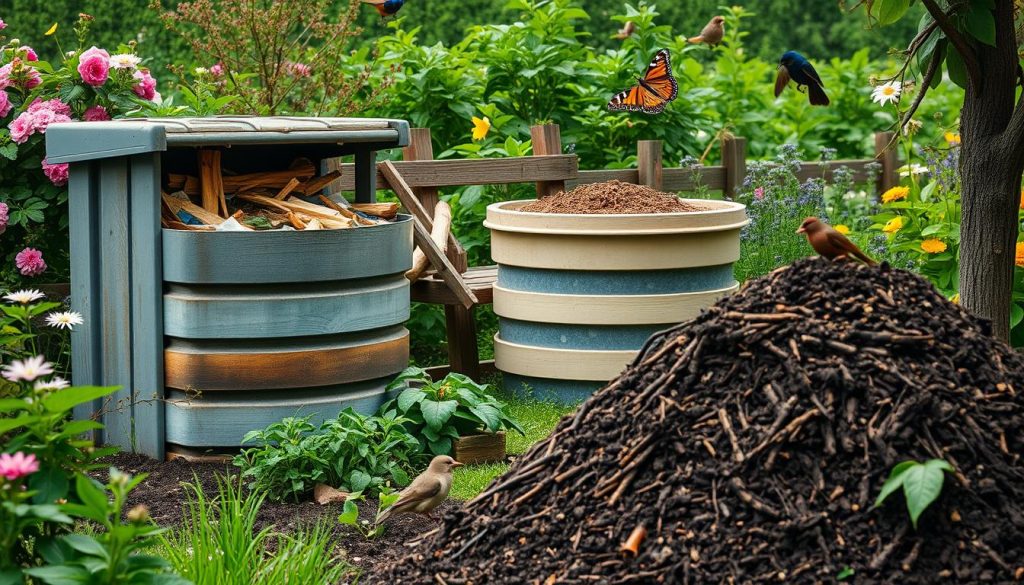
Utilizing Kitchen Scraps in the Garden
Kitchen scraps can be a great help for your garden. They provide nutrients and cut down on waste. By using green gardening ideas, you can make your garden more sustainable. You can even regrow veggies from scraps like lettuce, celery, and radishes.
Vegetables You Can Regrow from Scraps
Some veggies can grow back from scraps. This means you don’t need to buy new seeds. It also helps reduce waste. Here are some examples:
- Lettuce and other leafy greens
- Celery
- Radishes
- Green onions
Creative Ways to Use Fruit Peels
Fruit peels are also useful in the garden. They give nutrients and help keep pests away. For instance, citrus peels can keep pests off, and banana peels can feed your plants.
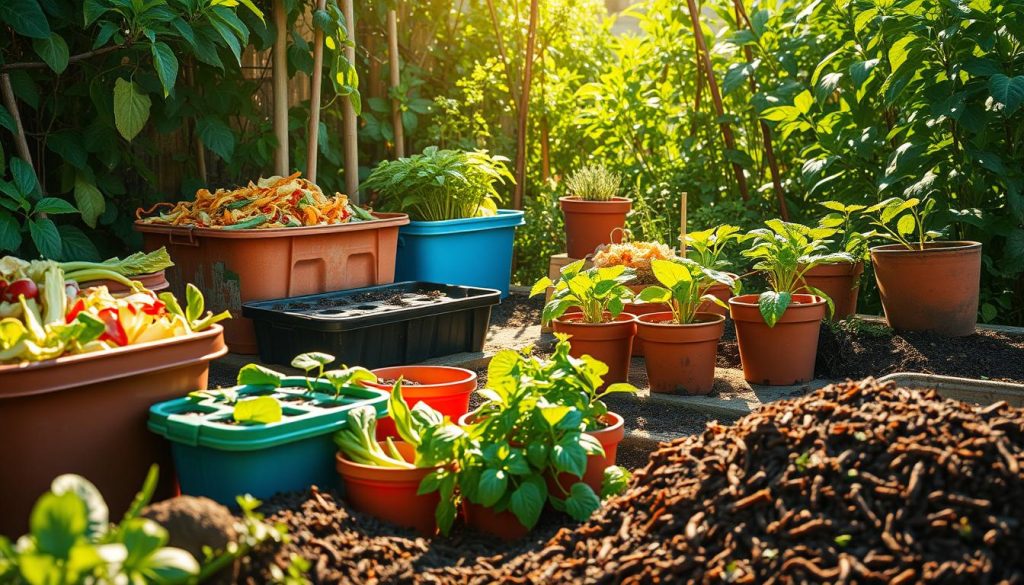
Repurposing Coffee Grounds and Eggshells
Coffee grounds and eggshells are good for your garden too. They add nutrients and make the soil better. Using these eco-friendly methods makes your garden more sustainable and friendly to the environment.
| Material | Use in the Garden |
|---|---|
| Coffee grounds | Natural fertilizer and pest control |
| Eggshells | Improves soil structure and deters pests |
| Fruit peels | Natural fertilizer and pest control |
Creating a Sustainable Garden Layout
As I work on my zero-waste garden, I’ve learned how crucial a sustainable garden layout is. It’s all about using eco-friendly gardening tips and practices. This way, I can cut down on waste and make a space that’s both beautiful and useful.
I think about a few important things when designing my garden. I place plants carefully, choose native species, and use companion planting. These steps make my garden look great and help the environment. They also make my garden more self-sufficient.
Some key tips I’ve picked up include:
- Using recycled materials for garden beds and pathways
- Incorporating native plants that need little care
- Implementing companion planting to fight pests and diseases
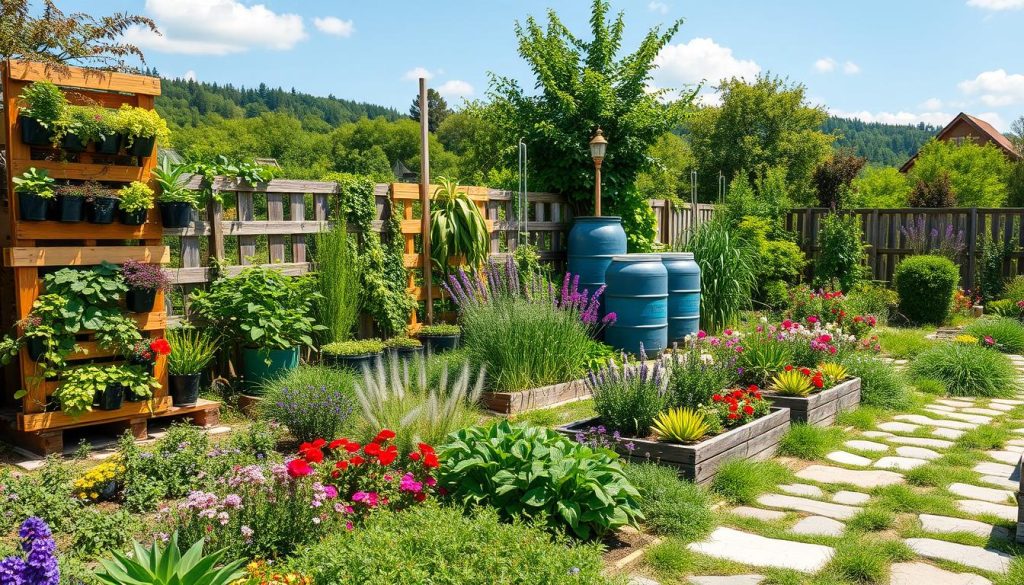
These eco-friendly gardening practices have helped me create a garden that’s good for the planet. It’s also a peaceful place for me to relax and have fun. As I care for my garden, I’m always reminded of the value of sustainable gardening.
| Native Plants | Companion Plants | Benefits |
|---|---|---|
| Tomatoes | Basil, Marigold | Improved flavor, reduced pests |
| Cucumbers | Dill, Radish | Increased growth, reduced diseases |
| Carrots | Sage, Rosemary | Improved flavor, reduced pests |
Choosing Eco-Friendly Gardening Supplies
To reduce waste in gardening, picking the right supplies is key. As a gardener, I’ve found that the tools and materials I use matter a lot. Using organic gardening techniques helps me keep my garden eco-friendly and healthy for my plants.
I search for tools and materials that are durable, reusable, and can break down naturally. My favorite tools include a wooden rake, a bamboo watering can, and stainless steel gardening scissors. These tools are good for the planet and last a long time.
My Favorite Eco-Friendly Gardening Supplies
- Biodegradable seed starters made from coconut coir or bamboo
- Sustainable mulching options like wood chips or straw
- Natural pest control methods using neem oil or diatomaceous earth
Using these eco-friendly supplies helps me garden in a way that’s better for the planet. Every small change we make can have a big impact. By choosing the right supplies, we can help the environment a lot.
Water Conservation Techniques
My journey to zero-waste gardening has shown me how vital water conservation is. Using minimal waste gardening solutions helps me use less water and make my garden more sustainable. One key method is collecting and storing rainwater for later use.
Some effective ways to save water include:
- Rainwater harvesting: collecting and storing rainwater in barrels or tanks for future use
- Using greywater: reusing water from sinks, showers, and washing machines for irrigation
- Creating a drip irrigation system: delivering water directly to the roots of plants, reducing evaporation and runoff
By using these methods, I can cut down on water use and make my garden more eco-friendly.
Rainwater Harvesting Ideas
Rainwater harvesting is a simple and effective way to collect and store rainwater for future use. By installing a rainwater harvesting system, I can collect and store rainwater in barrels or tanks, reducing my reliance on municipal water supplies.
Using Greywater in the Garden
Using greywater in the garden is another effective way to conserve water. By reusing water from sinks, showers, and washing machines, I can reduce the amount of water that enters the sewer system and create a more sustainable garden.
Creating a Drip Irrigation System
Creating a drip irrigation system is a great way to deliver water directly to the roots of plants, reducing evaporation and runoff. By using a drip irrigation system, I can significantly reduce my water usage and create a more efficient irrigation system.
| Water Conservation Technique | Benefits |
|---|---|
| Rainwater Harvesting | Reduces municipal water usage, decreases stormwater runoff |
| Using Greywater | Reduces water waste, creates a sustainable garden |
| Creating a Drip Irrigation System | Reduces evaporation and runoff, increases irrigation efficiency |
Attracting Pollinators and Beneficial Insects
Exploring green gardening ideas has shown me how crucial pollinators and beneficial insects are. They keep my garden healthy and diverse. By using eco-friendly gardening, like planting various flowers and herbs, I welcome these helpful insects.
Lavender, coneflower, and black-eyed susans are my go-to plants for bees and butterflies. Native plants also draw local pollinators. This ensures my garden meets their needs for food and shelter.
To make my garden a haven for pollinators, I avoid harmful chemicals. I use natural pest control methods like hand-picking and barriers. I also provide water, like a shallow dish or birdbath, to keep them hydrated.
- Plant a variety of flowers and herbs to attract pollinators
- Incorporate native plants into your garden
- Avoid using pesticides and herbicides
- Provide a source of water for pollinators
By following these tips, you can make your garden a green oasis. It will attract pollinators and support eco-friendly gardening. Every small change helps your garden and the environment a lot.
Sharing and Swapping with the Community
As I journey towards zero-waste gardening, I’ve learned the value of sharing and swapping. It helps spread sustainable gardening tips and practices. This not only cuts down on waste but also brings gardeners together.
Plant swaps are a great way to share and swap. Gardeners meet to exchange plants, seeds, and gardening knowledge. It’s a chance to learn new tips and methods.
The Benefits of Plant Swaps
Plant swaps have many advantages, including:
- Access to rare and unique plants
- Opportunities to learn from experienced gardeners
- A chance to share knowledge and expertise
Creating a Neighborhood Seed Library
A neighborhood seed library is another excellent way to share. It gives people access to different seeds and encourages sustainable gardening.
How to Host a Gardening Workshop
Hosting a gardening workshop is a fantastic way to share knowledge. It allows us to teach others about green gardening and sustainable tips.
By sharing and swapping, we build a greener gardening community. Let’s start making a difference for our environment!
| Activity | Benefits |
|---|---|
| Plant Swaps | Access to rare plants, learning opportunities, and knowledge sharing |
| Neighborhood Seed Library | Access to variety of seeds, promotion of sustainable gardening practices |
| Gardening Workshop | Teaching others about environmentally conscious gardening, providing sustainable gardening tips |
Reflecting on My Zero-Waste Gardening Journey
Looking back, I feel proud and thankful for my zero-waste gardening journey. I’ve learned so much and made mistakes that have helped me grow. These experiences have made me more determined to keep gardening sustainably.
Lessons Learned and Mistakes Made
Patience and persistence are key in zero-waste gardening. It takes time to get it right, and there will be mistakes. I’ve had to tweak my composting and water use, and find the right plants.
It’s not always easy, but seeing my garden thrive makes it all worth it.
My Favorite Success Stories
Seeing my efforts pay off is incredibly rewarding. Watching vegetables grow from scraps and seeing pollinators in my garden are highlights. Sharing my harvests with others is especially inspiring.
Inspiring Others to Go Zero-Waste
I want to encourage others to garden sustainably. Together, we can make a big difference. By gardening zero-waste, we can help create a greener future, garden by garden.

